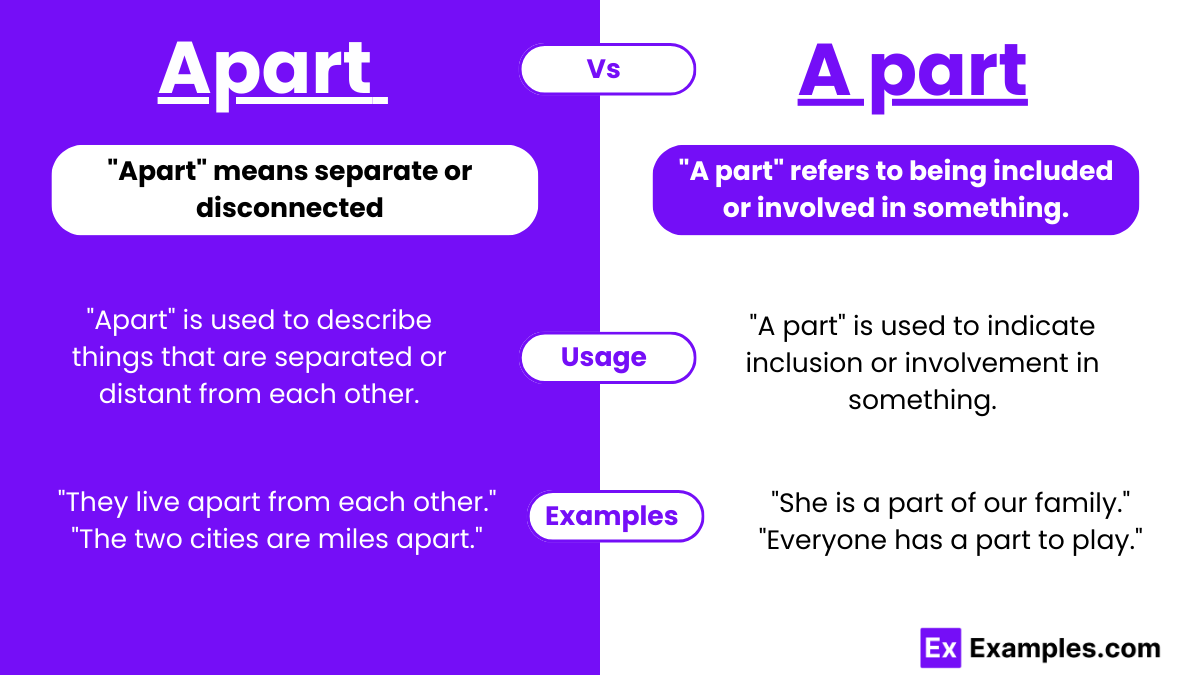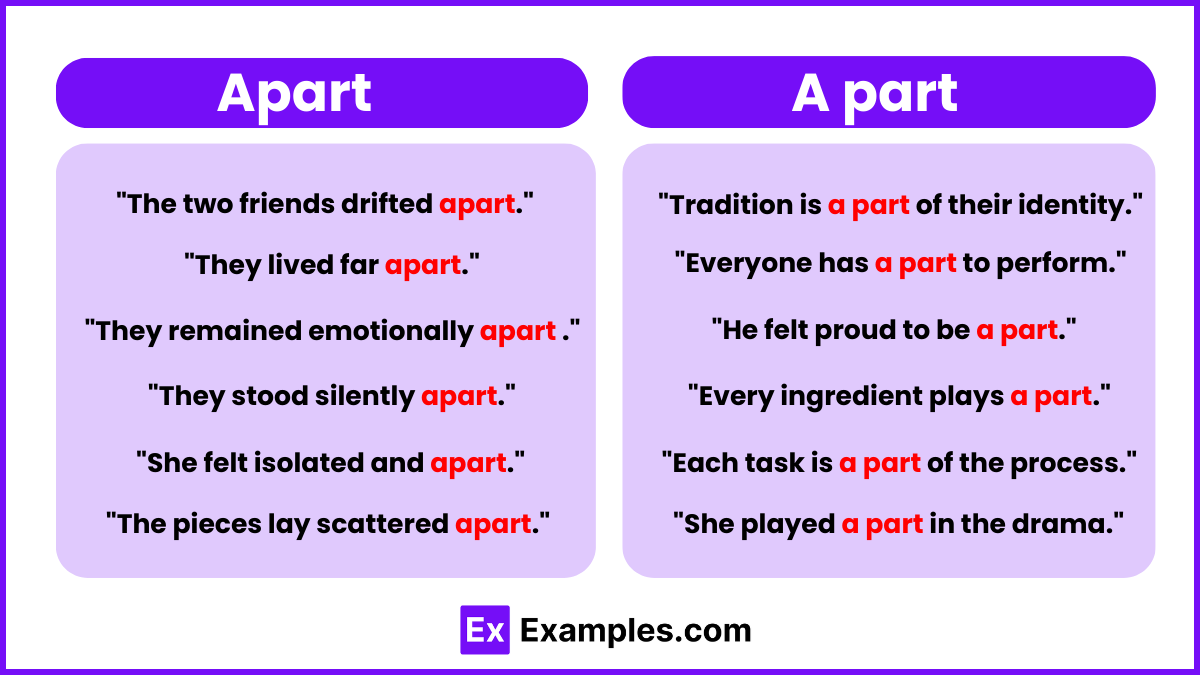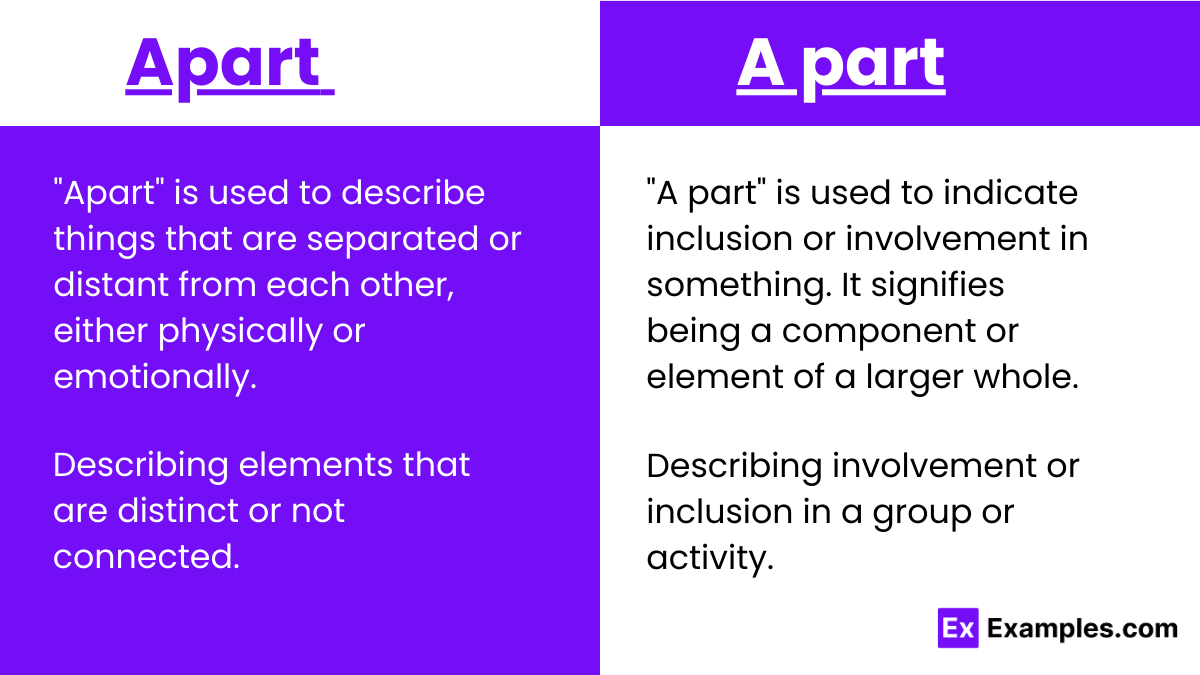Apart vs A part – Examples, Differences, Usage, Tips
Homophones are words or phrases that sound the same but have different meanings and spellings. “A part” and “apart” are common homophones that can trip up even the most experienced writers. Although they sound the same when said out loud, these words can’t be used interchangeably in your writing because they have different definitions and function differently within sentences. The English language often unveils pairs of words that, while nearly identical at a glance, hold distinct meanings and uses. Such is the case with “apart” and “a part,” two expressions that trip up many, particularly those who are not native speakers. “Apart,” used chiefly as an adverb, signifies a state of separation, creating a distance between entities. On the flip side, “a part,” comprising two words, denotes inclusion or a segment of a larger whole, whether it’s a slice of pie or an actor’s role in a play. This dichotomy between division and unity underlines the nuanced richness of English vocabulary.
The fascinating journey of “apart” and “a part” from their Latin roots to their current English forms mirrors the evolution of language itself. Stemming from the Latin ad (to) and pars (a piece or division), “apart” embodies the concept of division. Conversely, “a part” shares lineage with “partem,” the accusative form of “pars,” symbolizing a component of a larger entity. This linguistic twist, where a mere space differentiates separating from belonging, exemplifies the delicate balance and historical depth inherent in mastering English. Through exploring “apart” versus “a part,” students not only enhance their vocabulary but also connect with the intricate tapestry of language evolution.
Apart and A part – Meanings
Apart: Used predominantly as an adverb, “apart” conveys the idea of separation or distance between objects, places, or individuals. It implies a state of being away from something else or denotes a division that keeps elements distanced from each other. For instance, in the sentence “The siblings grew apart over the years,” “apart” illustrates an emotional distance that has developed over time. The term can also function in a spatial context, as in “Keep the fragile items apart to avoid damage,” where it suggests physical separation to prevent harm.
A Part: In contrast, “a part” (two words) refers to a component or piece of a larger whole, indicating inclusion rather than separation. It is often used to describe something that belongs to a bigger entity or is integral to the entirety. For example, “She was a part of the team that won the championship,” here, “a part” signifies the individual’s role as an integral member of the group. In the realm of theater or performance, “a part” can also refer to the role or character that an actor portrays, emphasizing their contribution to the overall production.
Summary
“Apart” typically functions as an adverb, emphasizing a notion of disconnection or spatial distance among entities, underscoring a detachment or division that maintains a separation. This term vividly captures scenarios where entities diverge, either emotionally or physically, as highlighted by siblings growing emotionally distant. Conversely, “a part” encompasses the notion of belonging, serving to identify a piece or element that is integral to a larger collective. It denotes involvement or membership within a broader group, such as an individual’s crucial role within a winning team, or an actor’s character in a play, reinforcing the concept of inclusion.
Difference Between Apart and A part
The distinction between “apart” and “a part” lies in their connotations of separation and inclusion, respectively, impacting their correct usage in English.
| Aspect | Apart | A Part |
|---|---|---|
| Function | Adverb | Noun phrase |
| Meaning | Indicates separation or distance | Refers to a piece or segment of a larger whole |
| Usage | To describe elements that are distanced from each other | To indicate inclusion or membership in a group |
| Connotation | Disconnection, division | Inclusion, belonging |
| Example | “The towns are miles apart.” | “She is a part of the choir.” |
| Phrase Usage | Often used in “apart from” | Used in “be a part of” |
| Context | Emotional, physical separation | Integration, involvement |
| Spatial Relation | Used to describe physical space between objects | Not used for spatial relations |
| Emotional Implication | Can imply emotional distance | Suggests being an integral component of something |
| Grammar Role | Predominantly an adverb | Functions as a noun within a noun phrase. |
Examples of Apart and A part
Exploring “apart” and “a part” through examples clarifies their distinct meanings and correct usage, enhancing comprehension and communication skills.
Apart Examples:
- “After the argument, they decided to live apart.“
- “Please keep the chemicals apart to prevent a reaction.”
- “The twins look alike, but their personalities are worlds apart.”
- “She tore the letter apart in frustration.”
- “To understand the mechanism, you must take it apart piece by piece.”
A Part Examples:
- “He became a part of the community after moving to the new town.”
- “A part of me wants to try the challenge, but I’m also scared.”
- “She played a part in the school play.”
- “This chapter is an essential a part of the textbook.”
- “A part of the proceeds will go to charity.”
When to Use Apart and A part
“Apart” from “A part” is essential for precise communication, as each term conveys opposing concepts of separation and inclusion, respectively
Usage of “Apart”
- Indicating separation or distance between people or things: “The two houses stood 50 feet apart.”
- Describing elements that are distinct or not connected: “Their opinions couldn’t be further apart.”
- Discussing the act of dividing or separating something into pieces: “She took the clock apart to fix it.”
Usage of “A Part”
- Referring to a piece or segment of a larger whole: “He’s a part of the chess club.”
- Describing involvement or inclusion in a group or activity: “She played a part in the play.”
- Highlighting a portion or component within a broader context: “A part of me knew it was a bad idea.”
Tips to remember Apart and A part
To ensure correct usage of “a part” and “apart,” consider these guidelines:
- Opt for “a part” when “one section” fits naturally into the sentence.
- “A part” is suitable when discussing a segment or fraction of a whole.
- “Apart” is the right choice if “excluding” or “other than” can be used as alternatives.
- Use “apart” to express physical or conceptual disconnection.
- “Apart” fits well where “at a distance from” makes sense in context.
- Assess whether the sentence requires a noun phrase (“a part”) or can be complemented by an adverb or adjective (“apart”). This understanding will enhance the quality of various written materials, from academic papers to professional documents, ensuring your language stands out for its clarity and precision.
FAQs
Is It Apart or A Part of a Team?
It’s “a part of a team.” The phrase “a part” signifies inclusion, indicating that someone or something belongs to or is included within the team.
Why Does Life Fall Apart?
Life “falls apart” when situations or relationships break down or fail, leading to a sense of disarray or separation from a previously stable state.
Is It Apart Of or A Part Of?
The correct phrase is “a part of.” It’s used to denote inclusion or belonging to a larger whole, whereas “apart of” is incorrect.
Is It Taking Something Apart or A Part?
It’s “taking something apart.” This phrase means to disassemble or dismantle something into its individual components or pieces.





